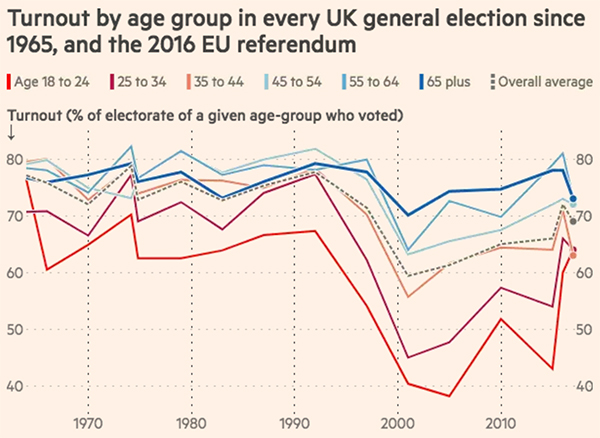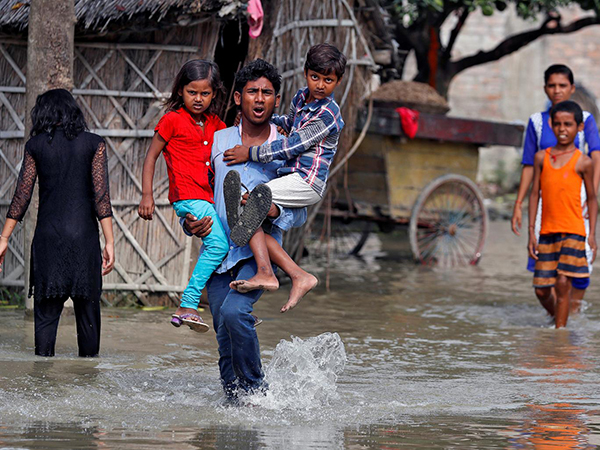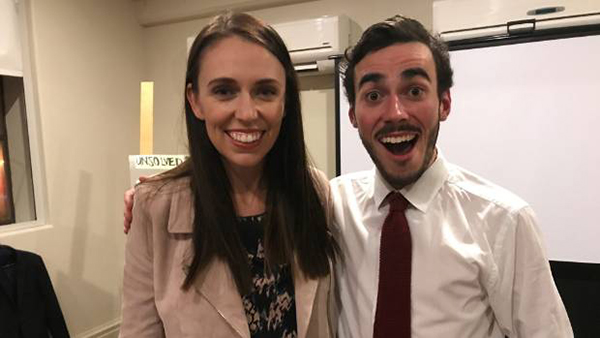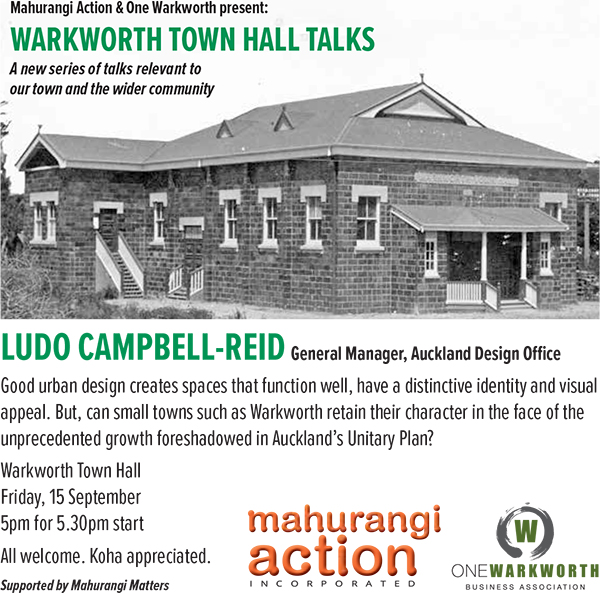Jacindaquake and Kids Voting curtain-raiser

Corbyn Foreshock: The youthquake resulting from people in the United Kingdom having something to vote for could be seen as a foreshock of the seismic rupture of the New Zealand electoral landscape. Bill ‘More Roads’ English complacently fancies few New Zealand voters wake up worrying about climate, but the polls emphatically state otherwise. chart John Burn-Murdock source British Election Study, Ipsos MORI
There’s no reason to imagine Aotearoa will be spared its youthquake.
In the United Kingdom, it was a 68-year-old Labour Party leader, Jeremy Corbyn, who triggered the tremor. The quake unleashed by the youth-adjacent Jacinda Ardern, who has just rocked the polls to a 12-year high, is likely to be of even greater magnitude.
Worldwide, voter turnout has been declining since the 1980s. Aside from the axiomatic need for leaders who resonate with the electorate, of the many interventions attempted, only voting in schools has a proven record for increasing engagement, long term. General exhortations to vote are an utter waste of public money, as are ad hoc adman-type excursions such as last year’s Auckland Council painting and decorating of a Volkswagen Kombi.
The particular egregiousness of the council’s ill-founded $1.2 million Kombi spend was that the former Auckland City Council pioneered the introduction of the evidence-based Kids Voting programme, from the United States. But, although Auckland has twice the rates of Kids Voting to the rest of the country, elsewhere, more than 90% of school students miss out. If the Labour Party possessed an ounce of strategic vision, it would be promising to provide students with universal access to a comprehensive voting-in-schools programme—building a base of involved young people would ensure that the party’s dark days of polling little above 20% were relegated to the mean-minded, evidence-free era it began by unleashing of the dogs of neoliberalism.

We Have a Houston Perception Problem: Not only has their president made the plight of half a million Texans displaced all about Trump, the Western media has made extreme weather, which is currently brutalising 41 million in Bangladesh, India and Nepal, all about the United States. The severity of these extreme weather events is fueled by fossil-fuel use, which, generalising, youth gets and age denies. Younger voters are desperately needed, if Labour is the receive unwavering electoral support for demonstrably overdue, meaningful climate action. image Reuters
The main danger of New Zealand’s youthquake is that a short-term bounce in young-person participation could further delay appreciation that voting in schools is the only measure that will ensure that youth turnout will improve in the long term. Richard Nixon’s election two terms after Jack Kennedy’s, and similarly Donald Trump’s, two terms after Barack Obama’s election, is proof of the ephemerality of time-for-greatness and yes-we-can campaigns. Now is the perfect time to ramp up evidence-based voter turnout interventions, and to trial some novel ones that available evidence suggests are likely to be effective. The first such novel intervention would cost nothing and would put the spotlight on voting in schools, when the greatest number of people are paying attention: Kids Voting as the curtain-raiser on the morning of 23 September.
As it stands, the Kids Voting results won’t be released until weeks later. Given that the Kids Voting polls close four days ahead of Election Day, relegating the results release the until way past the main event is hardly the way to demonstrate to students that voting-in-schools rates in the adult world. The argument that other poll results aren’t permitted be published on Election Day no longer holds water, given that many will have voted during the previous 12 days. On Election Day the mainstream media has a dearth of useful news to report, and even after the polls close at 7 pm, typically talks to itself for the next few hours. Given the thousands who made the pilgrimage to Sir Colin Meads’ funeral in Te Kūiti on Monday, it is unlikely that New Zealanders would fail to grasp the concept of a curtain-raiser.

Once were Bad as Each Other: Until Jacinda Ardern unashamedly owned climate action, with her nuclear-free moment, the Labour and National parties of Aotearoa were as good as each other at kicking the anthropogenic global warming can down the roads of national significance. Whether Labour can find the courage to confront its non-evidence-based anti-nuclear-power ideology, is quite another thing. image White Man Behind a Desk
Until Jacinda Ardern deftly took what for a lessor person would have assuredly been the mother-of-all hospital passes, there was every reason to bow to the conventional wisdom that New Zealand’s declining voter turnout was steep and persistent. But other countries are bucking the international trend, not least of all Estonia, since allowing its identity-card-carrying citizens the opportunity to vote online, and without the sky falling. The immensely well-funded and well-organised anti-online-voting lobby, of course, couldn’t give a fig about voting integrity—it is totally about voter suppression. Young people, like poor people, pose an enormous threat to the status quo, and they don’t accept for a second that the future of voting is other than online:
Even at a local body level, we think it would be incredibly beneficial to have online voting—it would allow the access of a whole, wide swathe of youth to get involved.

Local Turnout: The turnout that will do most for how the Mahurangi evolves is that to Ludo Campbell-Reid’s Warkworth Town Hall Talk, on 15 September, 5 for 5.30 pm. As Ludo puts it, ‘Change is inevitable. What is not inevitable however, is the quality of that change. It will require local leadership, imagination, vision, vigilance, skill and hard work to ensure that as it grows, it maintains its essential and unique qualities whilst discovering new and exciting possibilities for community building, environmental enhancement and economic development.’ image Mahurangi Matters
Meanwhile, Labour Party candidate for Rodney, Marja Lubeck, in response to the suggestion that now is the perfect time for Labour to commit to increasing support for evidence-based voting in schools programmes, so that the youthquake is maintained into the future, said:
Labour believes that it’s essential for New Zealand democracy to reverse the declining voting rate among young people. Labour’s Education policy and the School Leavers’ Toolkit, aims at providing young people with practical life skills so they’re better equipped in playing a role in shaping the world they live in.
Labour will create a School Leavers’ Toolkit to equip school leavers with vital life skills including:
- learning to drive and getting a licence
- having key workplace competencies
- having financial literacy and budgeting skills
- knowing their democratic rights and responsibilities.
Included in those democratic rights should be universal access to voting in schools, and Rodney residents, on Saturday morning 23 September, deserve to learn which electorate candidate is favoured by Rodney’s youth, while waiting to see how high the king-Ardern tide has lifted the all-important party vote for Labour, and how far it erodes National’s 19 204-party-vote margin, last time round.
Kids Voting—New Zealand’s Election Day curtain raiser.

I believe it would be extremely valuable to have timely publication of the results of mock elections held in schools. Doing so will elevate the exercise from a hypothetical event into an event that will spark a much wider debate. It will increase students’ confidence in the system, inspire and motivate them to vote ‘for real’.
Thank you for the important work you do, Marja